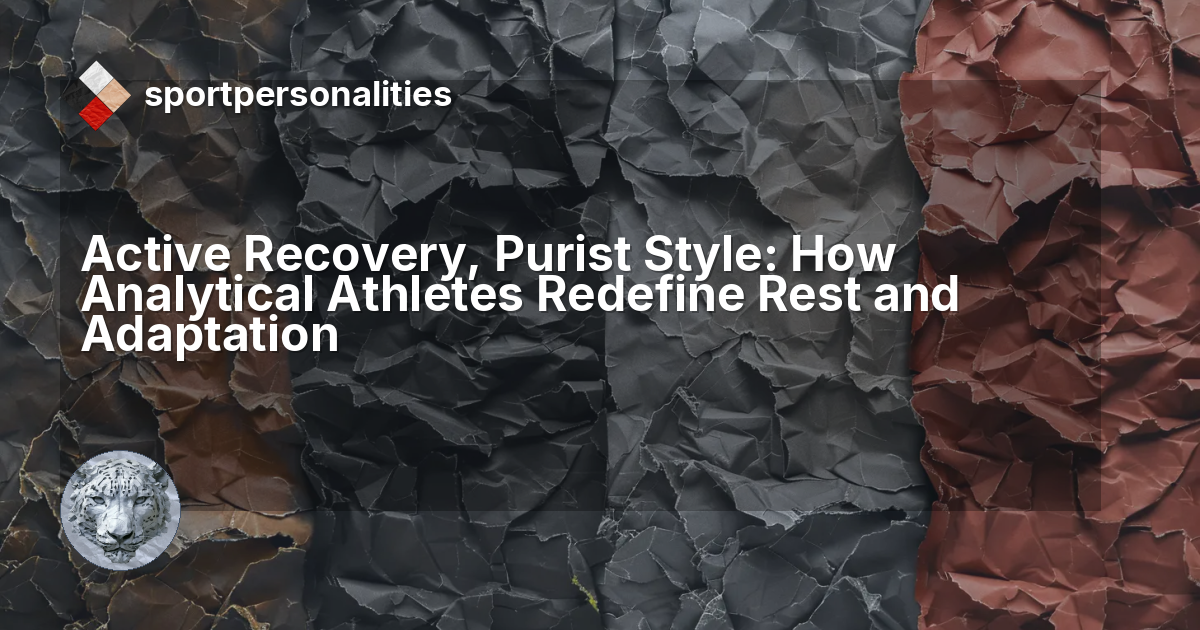Two types of athletes approach recovery differently. Most view rest as downtime, a necessary interruption to training where the body repairs itself through passive measures. Sleep happens. Muscles recover. They return to training when soreness fades.
Representatives of  The Purist (ISTA) sport personality type see something entirely different. For them, recovery represents an extension of the mastery process itself, a deliberate practice requiring the same analytical precision they apply to skill refinement. Where conventional athletes treat rest as the absence of training, Purists understand it as an active component of athletic evolution, demanding thoughtful attention and strategic implementation.
The Purist (ISTA) sport personality type see something entirely different. For them, recovery represents an extension of the mastery process itself, a deliberate practice requiring the same analytical precision they apply to skill refinement. Where conventional athletes treat rest as the absence of training, Purists understand it as an active component of athletic evolution, demanding thoughtful attention and strategic implementation.
This distinction matters. Recovery protocols directly influence the quality of subsequent training sessions, creating cascading effects on long-term skill development. For athletes driven by intrinsic motivation and the pursuit of technical excellence, understanding recovery through this lens transforms a biological necessity into another arena for refinement. This article examines the contrasting methodologies, explores why the Purist approach aligns with their psychological architecture, and provides frameworks for integrating both perspectives.
The Conventional Approach to Recovery
Traditional recovery protocols operate from a reactive framework. Athletes train until fatigue accumulates, then rest until symptoms diminish. The methodology centers on physiological markers: muscle soreness intensity, range of motion limitations, perceived energy levels. When these indicators return to baseline, training resumes at previous intensities.
This approach emphasizes passive recovery modalities. Athletes schedule rest days based on calendar intervals, every fourth day off, one light week per month. Active recovery, when implemented, follows generic prescriptions: easy cardio for twenty minutes, light mobility work, foam rolling tight areas. The strategy treats all athletes as interchangeable units responding predictably to standardized protocols.
External validation drives timing decisions. Competitive calendars dictate recovery schedules. Athletes push through fatigue when events approach, then crash afterward in unstructured rest periods. Performance metrics, race times, competition results, comparative rankings, serve as the primary feedback mechanism. Recovery adjustments occur only after performance declines become measurable.
The underlying philosophy views recovery as separate from training. Hard days develop fitness. Easy days permit adaptation. This binary thinking creates distinct mental categories: productive training versus necessary downtime. Athletes tolerate recovery rather than engaging with it, counting hours until they can return to "real" work.
Social dynamics reinforce this approach. Training partners compare volume metrics and intensity tolerances. Cultural narratives celebrate athletes who "push through" fatigue. Recovery becomes associated with weakness or insufficient commitment, something to minimize rather than optimize. The system works adequately for athletes motivated primarily by external outcomes and comparative performance.
How Purist Athletes Do It Differently
Purists construct recovery protocols as individualized experiments in physiological optimization. They track multiple data streams, heart rate variability, sleep architecture, subjective energy ratings, movement quality assessments, creating personalized baselines that account for their unique recovery patterns. Rather than following predetermined schedules, they adjust recovery timing based on these biomarkers, treating each training block as a distinct physiological state requiring tailored interventions.
Their analytical capabilities transform passive rest into active investigation. A typical Purist doesn't simply take an easy day; they design specific protocols testing recovery hypotheses. One session might explore whether low-intensity aerobic work accelerates lactate clearance compared to complete rest. Another examines how targeted mobility sequences affect subsequent technique execution. They document outcomes meticulously, building an evidence-based understanding of what facilitates their personal adaptation.
The Purist reframes recovery as skill refinement in a different domain. Where conventional athletes separate training from rest, Purists view recovery techniques, breathing protocols, sleep hygiene practices, nutritional timing, as learnable skills requiring the same mastery orientation they apply to sport-specific technique. They study recovery science with the same intensity they devote to tactical analysis, seeking not just general principles but specific applications to their athletic profile.
This approach extends to mental recovery patterns. Purists recognize cognitive fatigue as distinct from physical exhaustion, implementing structured variation in mental engagement. After sessions requiring intense technical focus, they might schedule physically demanding but cognitively simple activities. Following tactically complex training, they prioritize complete mental disengagement. The strategy acknowledges that mastery pursuits tax psychological resources requiring deliberate replenishment.
Their intrinsic motivation fundamentally alters recovery psychology. Without external pressure to perform on predetermined schedules, Purists can extend recovery periods when adaptation indicators suggest incomplete regeneration. They experience no anxiety about "falling behind" competitors during rest phases, understanding that inadequate recovery compromises the training quality that drives their mastery pursuit. This psychological freedom enables optimal biological adaptation rather than socially-determined timing.
Discover Your Sport Personality
This article explores one of 16 profiles. Find out which one you are and unlock a personalized blueprint for your athletic journey.
Take the Free TestWhy the Purist Method Works
The Purist recovery framework aligns precisely with their cognitive architecture, creating synergistic effects between psychological  Drive and physiological adaptation. Their analytical cognitive approach transforms recovery from a passive waiting period into an active learning process. Each recovery intervention becomes a data point informing future decisions. This continuous feedback loop satisfies their need for intellectual engagement while simultaneously optimizing biological regeneration.
Drive and physiological adaptation. Their analytical cognitive approach transforms recovery from a passive waiting period into an active learning process. Each recovery intervention becomes a data point informing future decisions. This continuous feedback loop satisfies their need for intellectual engagement while simultaneously optimizing biological regeneration.
Research in periodization science supports individualized recovery timing over standardized protocols. Studies examining heart rate variability-guided training demonstrate superior adaptation compared to predetermined schedules, with effect sizes ranging from 5-15% performance improvement. The mechanism operates through matching training stress to current physiological capacity rather than calendar-based assumptions. Purists naturally implement this principle through their systematic self-monitoring, adjusting protocols based on actual readiness rather than arbitrary intervals.
The intrinsic drive pillar provides crucial psychological advantages during recovery phases. External validation seekers often experience anxiety during rest periods, perceiving inactivity as lost ground against competitors. This stress response activates cortisol pathways that actively inhibit recovery processes, creating a biochemical contradiction where rest periods generate stress hormones. Purists, freed from comparative concerns, maintain parasympathetic nervous system dominance during recovery, facilitating optimal adaptation through reduced psychological interference.
Their individual  Social Style eliminates recovery-compromising social pressures. Training groups often create implicit norms around toughness and volume tolerance, where athletes feel compelled to match group training loads despite individual recovery needs. Purists, comfortable with autonomous decision-making, implement recovery protocols based on personal data rather than social expectations. This independence prevents the maladaptation spiral where inadequate recovery degrades training quality, reducing the stimulus that justifies the fatigue.
Social Style eliminates recovery-compromising social pressures. Training groups often create implicit norms around toughness and volume tolerance, where athletes feel compelled to match group training loads despite individual recovery needs. Purists, comfortable with autonomous decision-making, implement recovery protocols based on personal data rather than social expectations. This independence prevents the maladaptation spiral where inadequate recovery degrades training quality, reducing the stimulus that justifies the fatigue.
The strategic approach to competition manifests in sophisticated recovery periodization. Rather than maintaining constant training intensity punctuated by reactive rest, Purists design mesocycles with planned recovery phases positioned to maximize adaptation. They understand that supercompensation, the physiological rebound following strategic rest, represents an opportunity for performance breakthroughs. This tactical perspective transforms recovery from interruption into strategic advantage, aligning with their preference for thoughtful preparation over reactive responses.
Bridging Both Approaches
Optimal recovery strategies integrate conventional wisdom with Purist refinement, recognizing that both frameworks contain valuable elements. The traditional approach offers empirically-validated baseline recommendations: general sleep duration targets (7-9 hours), protein timing windows (within two hours post-training), active recovery intensity ranges (55-65% maximum heart rate). These evidence-based guidelines provide useful starting parameters before individualization.
Purists can benefit from structured recovery protocols during specific training phases. When preparing for technically complex skill acquisition, predetermined recovery schedules ensure sufficient regeneration without requiring constant self-monitoring. This approach conserves cognitive resources for the primary mastery task. The key lies in recognizing when standardized protocols serve the broader objective versus when individualized adjustment becomes necessary.
Conventional athletes gain substantial advantages by adopting Purist analytical methods within their existing framework. Simple implementations, tracking subjective recovery scores, monitoring resting heart rate trends, documenting training quality patterns, provide actionable data without requiring complete philosophical reorientation. These metrics reveal individual recovery signatures, enabling modest protocol adjustments that yield significant performance improvements.
The integration point centers on intentionality. Conventional recovery becomes Purist-aligned when athletes apply deliberate attention to rest periods, treating them as controllable variables rather than passive intervals. This might involve experimenting with sleep timing, testing different active recovery modalities, or documenting how various nutritional approaches affect subsequent training quality. The shift requires minimal time investment but fundamentally alters the recovery mindset.
Context determines appropriate methodology. Athletes training within rigid organizational structures, team schedules, coaching mandates, facility access limitations, benefit from conventional frameworks providing structure within constraints. Self-directed athletes pursuing long-term mastery gain advantages from Purist individualization. Many athletes operate in mixed contexts, requiring flexible approaches that adapt to situational demands while maintaining core principles.
Making the Transition
Implementation begins with establishing baseline recovery metrics. Athletes should track three variables daily for four weeks: subjective energy ratings on a 1-10 scale upon waking, resting heart rate measured before rising, and training quality assessments immediately post-session. This data reveals personal recovery patterns, how many days various training stimuli require for regeneration, which recovery modalities correlate with improved readiness, what early warning signs precede overtraining.
The second phase introduces systematic experimentation with recovery variables. Isolate single factors for two-week testing periods. One cycle might examine whether contrast water therapy (alternating hot/cold exposure) affects subsequent training quality compared to passive rest. Another tests whether carbohydrate timing modifications influence morning readiness markers. Document outcomes quantitatively, avoiding subjective interpretations unsupported by data. This process builds an evidence-based recovery protocol tailored to individual physiology.
Cognitive recovery requires parallel attention. Implement deliberate variation in mental engagement patterns. Schedule cognitively simple activities (equipment maintenance, easy aerobic work, passive mobility sessions) following training blocks demanding intense technical focus. Plan complete mental disengagement, nature exposure, non-sport social activities, creative pursuits, after periods of tactical analysis or strategic planning. Monitor how these patterns affect subsequent training quality and technical execution precision.
Advanced implementation involves recovery periodization aligned with training cycles. Design mesocycles with planned regeneration phases positioned to maximize supercompensation effects. A typical structure might include three weeks of progressive loading followed by one week at 50-60% normal volume, with the recovery week emphasizing technique refinement at reduced intensity rather than complete rest. This approach maintains skill practice while facilitating physiological adaptation.
The transition requires patience with the analytical process. Initial experiments may yield inconclusive results. Recovery patterns emerge over months, not weeks. Athletes must resist premature conclusions based on limited data, continuing systematic documentation until clear trends appear. This extended timeline aligns naturally with the Purist orientation toward long-term mastery rather than immediate results.
Integration challenges often arise from institutional pressures. Athletes operating within team structures may need to negotiate individualized recovery protocols with coaching staff. Present proposals using objective data, documented recovery metrics, peer-reviewed research supporting individualized timing, performance improvements from preliminary experimentation. Frame requests as optimization strategies rather than rejection of team methodology. Most coaches respond positively to evidence-based proposals demonstrating thoughtful analysis.
The ultimate integration synthesizes both approaches into a flexible framework. Maintain conventional baseline protocols providing structure and evidence-based guidance. Layer Purist analytical methods on top, creating individualized refinements informed by personal data. Recognize contextual factors determining when standardized versus customized approaches serve current objectives. This balanced methodology honors both empirical recovery science and individual physiological uniqueness.
The Path Forward
Recovery represents far more than biological necessity. For Purists, it constitutes another domain where mastery orientation applies, where analytical capabilities generate competitive advantages, where intrinsic motivation enables optimal adaptation. The conventional approach serves athletes pursuing external validation through standardized pathways. The Purist method aligns with those seeking genuine mastery through individualized refinement.
The distinction matters because recovery quality directly determines training quality, which ultimately shapes skill development trajectories. Athletes who treat recovery as passive downtime miss opportunities for systematic optimization. Those who approach it with the same analytical rigor they apply to technique refinement unlock adaptation potential unavailable through generic protocols.
Neither framework holds universal superiority. Context, objectives, and psychological architecture determine optimal methodology. The Purist approach demands time investment, analytical engagement, and comfort with self-directed experimentation. It rewards these investments with precisely calibrated protocols maximizing individual adaptation. Athletes possessing the patience for systematic investigation and the intrinsic motivation to pursue mastery through all training components will find this approach deeply satisfying and practically effective.
The path forward involves conscious choice about recovery philosophy. Will rest remain something that happens between training sessions, or will it become another arena for deliberate practice and continuous refinement? For Purists, the answer emerges naturally from their core athletic identity. Recovery, like all aspects of sport, becomes an opportunity for the quiet devotion to craft that defines their pursuit.
This content is for educational purposes, drawing on sport psychology research and professional experience. I hold an M.A. in Social Psychology, an ISSA Elite Trainer and Nutrition certification, and completed professional training in Sport Psychology for Athlete Development through the Barcelona Innovation Hub. I am not a licensed clinical psychologist or medical doctor. Individual results may vary. For clinical or medical concerns, please consult a licensed healthcare professional.

